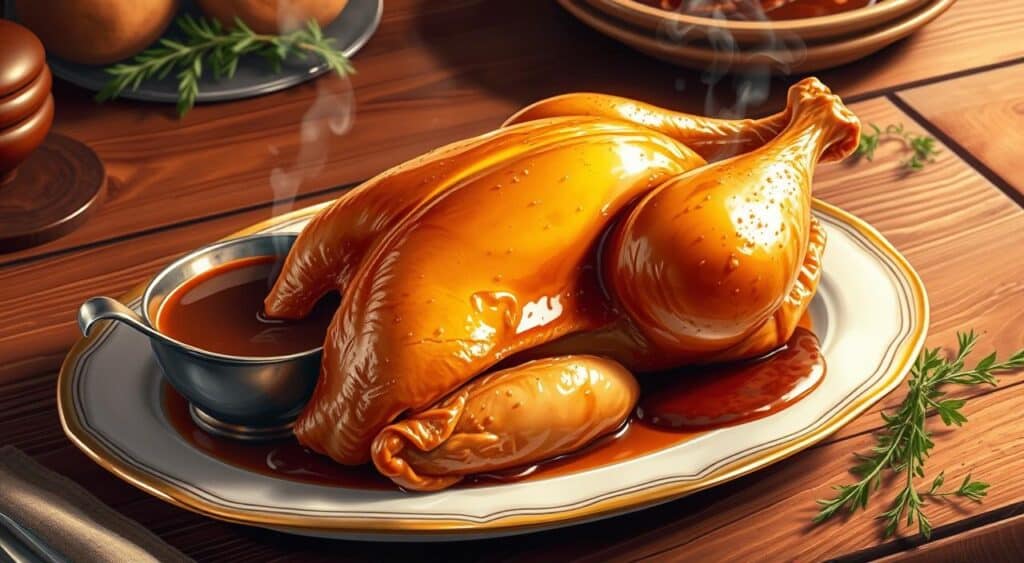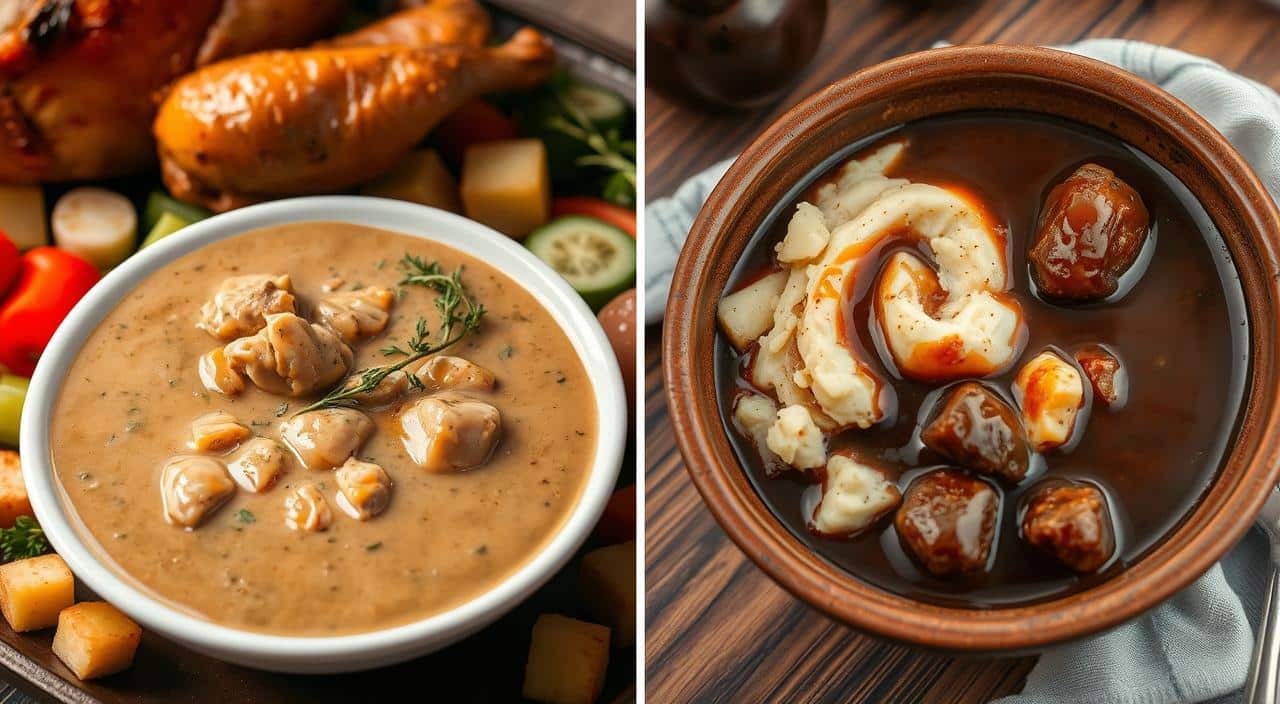Jump to:
Estimated reading time: 8 minutes
Table of contents
The right gravy can really elevate your favorite dishes. Chicken gravy and brown gravy are two popular choices, but what makes them different? By comparing them, you can learn about their unique ingredients, flavors, and best uses. This article will help you understand the main differences between chicken and brown gravy. This way, you can pick the perfect gravy for your next meal.
If you’re a home cook wanting to improve or just curious about these gravies, this guide is for you. We’ll cover everything from the main ingredients to the best cooking methods and pairings. So, let’s get started and see what makes these gravies special!
Key Takeaways
- both gravies have distinct ingredients that impact their flavors
- Cooking methods and techniques differ between the two
- Each gravy pairs well with specific dishes based on its unique taste profile
- Understanding the differences allows you to choose the best gravy for your meal
- Comparing the two helps elevate your cooking and dining experience
Introduction
Chicken gravy and brown gravy are staples in American cuisine. They add unique flavors and textures to many dishes. These sauces make simple meals more comforting and satisfying. Knowing the differences between chicken and brown gravy can help you make tastier meals.

Both gravies have a long history in American cooking. They trace back to early colonial times. Over time, these gravies evolved with the country, leading to many regional variations today.
Now, let’s explore both. We’ll look at their ingredients, cooking methods, and how to use them in dishes. By the end, you’ll know when to pick chicken or brown gravy to enhance your cooking.
“Gravy is the simplest, tastiest, most memory-laden dish I know how to make: a little flour, salt and pepper, crispy bits of whatever meat anchored the meal, a couple of cups of water or milk and slow stirring to break up the lumps.” – Dorothy Allison, American writer
Join us as we discover the secrets of two beloved American gravies. Whether you prefer the rich taste of brown gravy or the comforting flavor of chicken gravy, there’s something for everyone in this guide.
Ingredients in Both Gravies
Choosing the right ingredients can greatly change the taste and texture of your gravy. Let’s explore the main ingredients in chicken gravy and brown gravy. We’ll see how they impact the flavor.
Main Ingredients for Chicken Gravy
The key ingredients in chicken gravy are:
- Chicken stock or broth
- Butter or oil
- Flour (for thickening)
- Salt and pepper
- Optional herbs and spices (e.g., thyme, sage, or garlic powder)
Chicken stock or broth gives the gravy a rich, savory taste. Butter or oil helps make a roux with flour. This roux thickens the gravy and adds a smooth texture.
Main Ingredients for Brown Gravy
Brown gravy includes these ingredients:
- Beef or vegetable stock
- Butter or oil
- Flour (for thickening)
- Onion powder
- Garlic powder
- Worcestershire sauce
- Salt and pepper
Beef or vegetable stock is the base for brown gravy, unlike chicken stock. It gives the gravy a deeper flavor. Onion powder, garlic powder, and Worcestershire sauce add savory notes and complexity.
How the Ingredients Affect Flavor
Each type of gravy gets its unique flavor and texture from its ingredients. Here’s how they compare:
| Gravy Type | Key Ingredients | Flavor Profile |
|---|---|---|
| Chicken Gravy | Chicken stock, butter, flour, salt, pepper, herbs | Lighter, milder flavor with a smooth texture |
| Brown Gravy | Beef or vegetable stock, butter, flour, onion powder, garlic powder, Worcestershire sauce | Richer, more robust flavor with a slightly thicker consistency |
Knowing how ingredients affect gravy flavor lets you tailor your recipes. This way, you can make the perfect gravy for any dish.
Cooking Methods:
When cooking both of them, different techniques are used to get the right flavors and textures. Knowing these methods can help you make both better. This can make your meals taste amazing.
Cooking Techniques for Chicken Gravy
Chicken gravy starts with a roux, made from butter and flour cooked until it smells nutty. This roux thickens the gravy. Then, slowly add chicken stock or broth, making sure it’s smooth without lumps. Let the gravy simmer until it’s thick enough, stirring now and then. Adding herbs, spices, or a bit of white wine can make it even tastier.
How Brown Gravy Is Made
Brown gravy uses drippings from cooked meat. After taking the meat out, heat the drippings and make a roux with flour. This roux turns golden brown, which is called deglazing. It mixes in the tasty bits from the pan.
Slowly add beef or vegetable stock, whisking well to avoid lumps. Let the gravy simmer until it’s thick and the flavors blend well.
Differences in Cooking Times and Techniques
Both gravies need a roux and simmering, but they differ in time and method. Chicken gravy cooks faster, with a light golden roux. Brown gravy takes longer for its darker roux, which gives it a deeper flavor.
Chicken gravy uses chicken stock, while brown gravy often has beef or vegetable stock. This choice of stock changes the gravy’s taste. Changing the roux ratio can also adjust the gravy’s thickness and texture.
| Gravy Type | Roux Color | Liquid Base | Cooking Time |
|---|---|---|---|
| Chicken Gravy | Light Golden | Chicken Stock/Broth | 10-15 minutes |
| Brown Gravy | Dark Brown | Beef/Vegetable Stock | 20-25 minutes |
Learning how to make gravy cooking techniques for chicken and brown gravy lets you create tasty sauces for many dishes. Try different ingredients and cooking times to find your favorite gravy.
Best Uses for Both
Choosing the right gravy can make your meals shine. Each bring unique flavors to the table. Let’s look at the best uses for both gravies, and when to pick one over the other.
Dishes That Pair Well with Chicken Gravy
Chicken gravy is great with many classic comfort foods. It’s a perfect match for:
- Roasted or grilled chicken
- Creamy mashed potatoes
- Fluffy biscuits or dinner rolls
- Chicken pot pie
- Chicken fried steak
Chicken gravy’s smooth texture and mild flavor boost these dishes. If you have leftover chicken gravy, use it in your favorite recipes.
Popular Uses for Brown Gravy
Brown gravy has a deep, rich flavor. It’s great with hearty meals like:
- Roast beef or prime rib
- Shepherd’s pie or cottage pie
- Salisbury steak
- Meatloaf
- French fries or roasted potatoes
Brown gravy’s beefy taste enhances these dishes. It adds depth and complexity. Brown gravy is perfect for a classic Sunday roast or shepherd’s pie.
When to Choose Chicken Gravy vs Brown Gravy
Choosing between the two depends on your dish’s flavor and ingredients. Chicken gravy goes well with poultry, while brown gravy suits beef and red meat.
But, there are exceptions. For a dish with delicate flavors, like smoked salmon, choose a lighter chicken gravy. For vegetarian meals with bold flavors, a rich brown gravy can be a great choice.
Experiment and find what you like best. Don’t hesitate to try new combinations. Discover your favorite pairings for both of them.
Frequently Asked Questions.
What is the difference between chicken gravy and brown gravy?
The primary difference between chicken gravy and brown gravy is the base stock used to make each. Chicken gravy is made using chicken broth or drippings, resulting in a lighter color and milder flavor that pairs well with poultry. Brown gravy, on the other hand, is made with beef broth or drippings, giving it a richer, darker color and a more robust flavor suitable for red meats.
Are the seasonings different in chicken gravy and brown gravy?
Yes, the seasonings can differ. Chicken gravy typically includes milder seasonings like thyme, sage, and garlic powder to complement the lighter chicken flavor. Brown gravy may use rosemary, black pepper, and Worcestershire sauce for a bolder, heartier taste.
How is chicken gravy made compared to brown gravy?
Both types of gravy use similar techniques, such as starting with a roux (flour and fat mixture) to thicken the sauce. Chicken gravy is made by whisking chicken broth into the roux, while brown gravy uses beef broth or drippings. Some recipes also add a touch of cream or milk to chicken gravy for extra richness, while brown gravy remains more savory.
Can you substitute chicken gravy for brown gravy?
Yes, you can substitute them in a pinch, but the flavor profile will be different. If substituting, you might want to add a bit of Worcestershire sauce or soy sauce to chicken gravy to deepen its flavor for dishes traditionally served with brown gravy, like beef or mashed potatoes.
Conclusion: Understanding the Differences Between Chicken Gravy and Brown Gravy
Both may look similar, but they have many differences. Chicken gravy uses chicken stock or broth and drippings from roasted chicken. It also includes butter, flour, and seasonings like salt and pepper. This makes a light-colored gravy with a unique chicken taste. It goes well with roasted chicken, turkey, mashed potatoes, and rice.
Brown gravy, however, gets its deep color and taste from beef stock or broth and pan drippings from beef or other meats. It’s made with flour, butter, and seasonings like onion and garlic. This gravy is great with roast beef, meatloaf, Yorkshire pudding, and stews.
Knowing the differences between chicken and brown gravy helps home cooks improve their meals. You can try both gravies in your cooking with the tips from this article. With practice, you’ll make gravies that match your favorite dishes perfectly.






